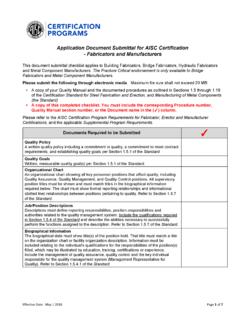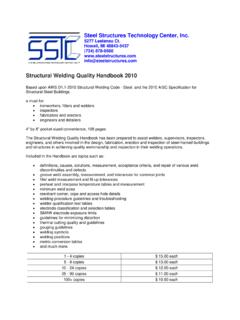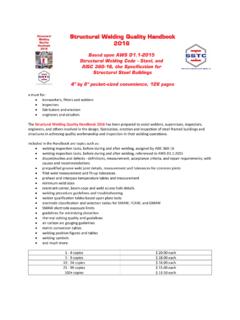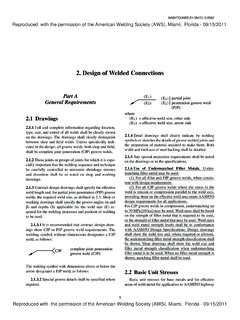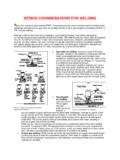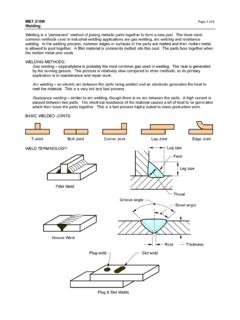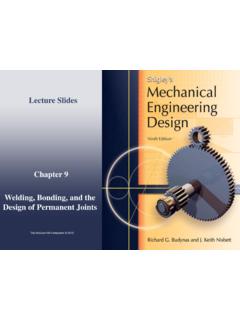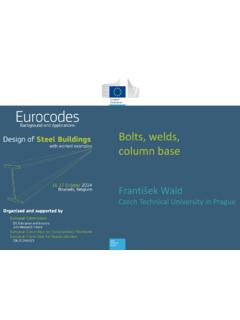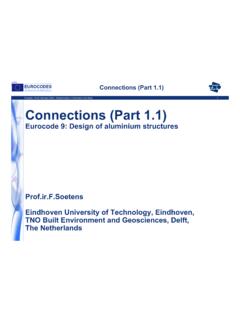Transcription of Keeping Fillet Welding in CHECK - AISC Home
1 Call the effective throat of the Fillet strength of Fillet welds is covered in Section of the AISC Specifica-tion. For the base metal, the strength is calculated based on the cross-sectional area of the base metal, ABM , which is based on the shear planes identified in Figure 1. For the weld metal, the strength is based on the effective area of the weld , Awe, which is shown in Figure 1. Note that Figure in the Commentary on the AISC Specification also identifies the shear planes for Fillet welds loaded in longitu-dinal shear (Figure 2).
2 Keeping Fillet Welding in CHECKA couple of common questions (and answers) on checking Fillet weld IT COMES to Welding , the AISC Steel Solu-tions Center receives quite a few questions on these two Fillet Welding topics: (1) the need to CHECK the fusion zone for Fillet welds; and (2) how and when to CHECK the shear plane for Fillet welds. Here are some insights on Zone Let s start with the fusion zone question. Figure 1 il-lustrates both the fusion zone and the shear planes for a near-side far-side Fillet weld . The weld shear planes are at the bisector of the dihedral angle what we commonly BY CARLO LINI, 2016 Carlo Lini is an advisor in AISC s Steel Solutions 1.
3 Shear planes and fusion zones for longitudinal Welded ConnectionFusion ZonesShear PlanesFusion ZoneFusion ZoneShear PlaneMaterial AShear PlaneMaterial BVV/2V/2 weld ShearPlaneMaterial AMaterial BFillet WeldedConnectionFusion ZoneShear Planes Figure 2. Shear planes for Fillet welds loaded in longitudinal shear. Modern STEEL CONSTRUCTION Notice that there are no require-ments for checks on the fusion zone in Section This CHECK is not required because the required filler metal strength per Table of the AISC Specification must be equal to or less than matching.
4 Note that Table does permit the use of filler metal with a strength level one greater than stated in the footnote to Ta-ble , Section of AWS defines levels of matching. However, one can loosely summa-rize the terms as follows:TABLE (excerpt)Available Strength of Welded Joints,ksi (MPa)Load Type and Direction Relative to weld AxisPertinent Metal and Nominal Stress (FnBM or Fnw ) ksi (MPa)Effective Area (ABM or Awe ) (mm2)Required Filler Metal Strength Level [a][b] Fillet WELDS INCLUDING FILLETS IN HOLES AND SLOTS AND SKEWED T JOINTSS hearBaseGoverned by J4 Filler metal with astrength level equalto or less thanmatching filler metalis = = [d]See orcompressionParallel to weld axisTension or compression in parts joined parallelto a weld need not be considered in designof welds joining the good discussion on matching, undermatching and over-matching filler metal strengths is provided in AISC Design Guide 21.
5 Welded Connections A Primer for Engineers (a free download for AISC members at ). As summarized in the guide, Standard design procedures do not consider the base metal strength, since the assumption is that the weld metal throat will theoretically control. This is a conservative assumption, provided that matching or undermatching filler metal is used. Base Metal Shear Plane ChecksRegarding the second topic when and how to CHECK a shear plane in the base metal adjacent to the Fillet welds this stems from what seems to be an overuse of Equation 9-2 and 9-3 in Part 9 of the 14th Edition AISC Steel Construction Manual.
6 The intent of providing these equations is as follows: In many cas-es, the load path from a weld to the connecting element can be evaluated directly. However, in some cases, the available strength of the connecting element is not directly calculable. For example, while the strength of the beam-web welds for a double-angle connection can be directly calculated, the strength of the beam web at this weld cannot. In cases such as these, it is often con-venient to calculate the minimum base metal thickness that will match the available shear rupture strength of the weld (s).
7 Figure 3 illustrates a common condition where Equations 9-2 and 9-3 are used to CHECK the base metal strength. Unfortunately, it is not uncommon to see a similar CHECK of the base metal even when the load path from a weld to the con-necting element can be evaluated directly, such as when con-necting a single-plate connection to a column flange. In such cases, it is completely sufficient to CHECK the base metal directly and not necessary to use the comparative calculation approach we adopt when the direct CHECK is not possible.
8 The compara-tive approach, in a lot of cases, will be overly conservative when checking the base metal strength relative to the weld strength, which is likely based on a Fillet weld size that has been rounded up to the nearest 1/16th of an inch or is based on a minimum Fillet weld should also consider if a shear rupture CHECK of the base metal is necessary. Whether one decides to CHECK shear rupture at this location or similar locations is a matter of engineering judg-ment, although I do not believe this CHECK is typically necessary It would be similar to checking the column flange of a bolted connection for shear rupture (Figure 4), which is typically not done.
9 If this happens to be a controlling limit state, you should consider if the CHECK is necessary before reinforcing is required or the member size is increased. Figure 3. Base metal CHECK along C-shaped 4. Comparison of a welded and bolted connection to a column flange for shear rupture Metal Checkat WeldBase Metal CHECK at weld minimum weld Strength < minimum Material Tensile Strength Undermatching Filler Metal minimum weld Strength = minimum Material Tensile Strength Matching Filler Metal minimum weld Strength > minimum Material Tensile Strength Overmatching Filler Metal





